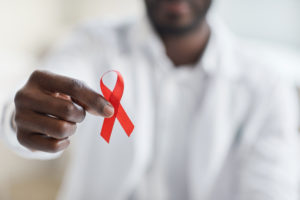A new study uncovered large and persistent disparities by sex and age in the uptake of a preferred HIV medication in low- and middle-income countries, potentially subjecting some women to worse HIV treatment outcomes if the situation is not corrected quickly.
- In the large observational cohort study of 134,672 people with HIV at 87 facilities in 11 countries, researchers at the Institute for Implementation Science in Population Health (ISPH) at the CUNY Graduate School of Public Health and Health Policy (CUNY SPH) found the lowest uptake of the drug dolutegravir to be among women of reproductive age.
- The researchers attribute these disparities to concerns related to a report in 2018 of a possibly increased risk of neural tube defects in infants born to women with HIV taking dolutegravir at conception. After further investigation of this safety signal and assessment of the risks vs. benefits, the World Health Organization (WHO) recommended dolutegravir for all people with HIV in July 2019.
- Despite the updated guidance from WHO, the researchers found that these large disparities persisted through the end of their study in March 2020 such that only 29 percent of female patients aged 16-49 years had initiated dolutegravir compared with 58 percent of male patients aged 16-49 years.
- The study has policy and program implementation implications for national AIDS programs and large scale initiatives, such as the US PEPFAR program, which are striving to ensure that women with HIV get the most health benefit from their HIV treatment regimen.
The study, published in the latest issue of the Annals of Internal Medicine, examined HIV care data from January 2017 through March 2020 from sites participating in the International epidemiology Databases to Evaluate AIDS (IeDEA) from the Asia-Pacific, Caribbean, Central and South America network for HIV epidemiology (CCASAnet), and the Central, East, and Southern Africa regions. Patients included in the study were either newly initiating or already on antiretroviral therapy, and received HIV care at sites that had begun to prescribe dolutegravir. Overall, 134,672 patients were included at 87 facilities in 11 countries. By the time the safety signal emerged in May 2018, the global transition to dolutegravir was just beginning, with only 3 percent of patients on the drug.
“The identification of a post-marketing safety signal is a turning point filled with uncertainty,” said the study’s lead author, Matthew Romo, Research Scientist at the ISPH and PhD candidate at CUNY SPH. “In that time of uncertainty, policy-makers, clinicians, and patients are forced to weigh this new potential risk with what is already known about safety and efficacy until more data are available.”
Dolutegravir is an important tool in ending the HIV epidemic as a global public health threat. In addition to improving patient treatment outcomes, its superior efficacy profile has implications for reducing onward HIV transmission to sex and needle sharing partners, as well as in pregnancy.
“During the initial dolutegravir roll out, many women were effectively denied access to a superior antiretroviral therapy regimen,” said Dr. Romo.
“The large disparities quantified by our study mean that missed or delayed opportunities to improve HIV treatment outcomes could be substantial over the long run if they are not corrected quickly”, said CUNY SPH Distinguished Professor of Epidemiology Denis Nash, the senior author on the study and one of the Principal Investigators of the Central Africa IeDEA regional collaboration. “We need more rapid and robust pharmacovigilance surveillance both before and after safety signals, which is important for reliably detecting, characterizing, and quantifying adverse events, in order to rigorously inform implementation decisions about the use of pharmaceuticals on a large scale.”
Moreover, Dr. Romo said, “The next time a safety signal emerges potentially implicating an antiretroviral drug with a birth defect, women living with HIV must have a seat at the table in developing policies that govern their access to the drug.”
This research was funded by the National Institutes of Health’s National Institute of Allergy and Infectious Diseases; the Eunice Kennedy Shriver National Institute of Child Health and Human Development; the National Cancer Institute; the National Institute on Drug Abuse; the National Heart, Lung, and Blood Institute; the National Institute on Alcohol Abuse and Alcoholism; the National Institute of Diabetes and Digestive and Kidney Diseases; the Fogarty International Center; the National Library of Medicine; and the Office of the Director; and the CUNY Institute for Implementation Science in Population Health.
Media contact:
Ariana Costakes
Communications Editorial Manager
Ariana.Costakes@sph.cuny.edu
About CUNY ISPH
The CUNY Institute for Implementation Science in Population Health (ISPH) was founded on the notion that substantial improvements in population health can be efficiently achieved through better implementation of existing strategies, policies, and interventions across multiple sectors. We study how to translate and scale-up evidence-based interventions and policies within clinical and community settings in order to improve population health and reduce health disparities. CUNY ISPH. Pursuing population health gains through better implementation. www.cunyisph.org. Follow us on Twitter: @CUNYISPH.
About CUNY SPH
The CUNY Graduate School of Public Health and Health Policy (CUNY SPH) is committed to promoting and sustaining healthier populations in New York City and around the world through excellence in education, research, and service in public health and by advocating for sound policy and practice to advance social justice and improve health outcomes for all.
Citation: “Disparities in dolutegravir uptake affecting females of reproductive age with HIV in low- and middle-income countries after initial concerns about teratogenicity: An observational study,” Matthew L. Romo, Rena C. Patel, Jessie K. Edwards, John M. Humphrey, Beverly S. Musick, Caitlin Bernard, Mercy W. Maina, Ellen Brazier, Barbara Castelnuovo, Jeremy Penner, Katarzyna Wyka, Sandra Wagner Cardoso, Penh Sun Ly, Cordelia Kunzekwenyika, Claudia P. Cortés, Radoslaw Panczak, Elizabeth A. Kelvin, Kara K. Wools-Kaloustian, and Denis Nash, on behalf of International epidemiology Databases to Evaluate AIDS (IeDEA), Annals of Internal Medicine, published online November 30, 2021. PMID: 34843382, DOI: 10.7326/M21-3037



